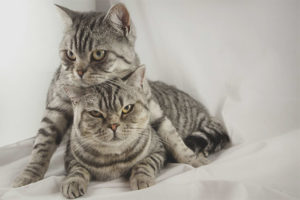The content of the article
The reaction of any cat owner to her refusal to use the tray as a toilet will be different. For one it will be a situation that brings a little discomfort, and which he will try to fix, for the other the best solution would be getting rid of a pet. Unfortunately, the latter option is more common.
But, nevertheless, I would like to remind you that, like the animal, its owner also has certain obligations, and if problems arise, he must make every effort to resolve them successfully.
How to understand what the cat wants?
I would like to note that a sharp change in the behavior of fluffy pets always has its own, although not always obvious reasons. An animal, which from a young age was accustomed to go to the tray, just like that will never soil in the dwelling.This is due to the fact that such oddities are not peculiar to cleanly purring.
There are a number of common reasons that most experts associate with the refusal of cats to go to the tray:
- Strangely enough, the leading position is occupied by stress, which can be caused by almost anything - from resentment towards the owner and to fright from a loud noise.
- Another serious reason for the experience may be the appearance in the house of a new family member.
- Poorly located tray or incorrectly selected tray filler.
- Jealousy caused by other pets.
The manifestation of natural instincts
Although cats are considered domesticated animals, nevertheless, this does not mean at all that they have forgotten about their natural instincts. The most obvious of them is the desire to protect themselves.
As a rule, this is achieved by the fact that the dwelling in which the cat or cat lives should have “its own” smell. To do this, it must be marked with secretions secreted by the glands. During the period of sexual hunting, such fragrances are significantly enhanced by a mixture of urine and secretions secreted by the glands located under the tail of the animal.
Surely every pet owner noticed how the last one, lifting the tail, generously sprinkled the corners of the rooms and the area in front of the entrance doors. The appearance of such instincts for an animal is quite natural and, accordingly, it does not understand when it is scolded and punished for it. Based on the fact that an adult animal at a tender age was accustomed to the tray, but suddenly the room began to get dirty now, then the whole thing in puberty.
In order to solve the problem, you can use one of the methods below.
- Regularly wash out all corners marked by animals and hope that soon your pet or pet will calm down. Nevertheless, as practice shows, even the most expensive sprays and detergents are powerless before the sexual hunt. By diligently removing the cat tags, you are forcing the pet even more diligently to mark its territory.
- Some cat owners restrain their pets' instincts through special hormonal means (injections, pills). The action of drugs of this type is mainly aimed at artificial regulation of hormonal levels.The disadvantage of this decision is the potential harm to the health of the caudate ward (the risk of developing cancer).
- Sterilizing an animal is one of the surest ways to do away with tags. As a rule, the duration of hormone fluctuations is from 2 months to six months. Then the sexual instinct weakens, and the pet will not feel the need to attract sexual partners. Nevertheless, it should be borne in mind that sterilization is not shown to all animals. The most valid reason for refusing this procedure is tribal value. Also, you can not sterilize animals with heart problems or acutely reacting to the use of anesthesia. The recommended age for sterilization is from six months to eight years.
Features of the physiology of cats as the cause of "bad" behavior
If your pet, who regularly used the tray for several years, stopped walking in it, that is:
- The cat decided that its tray had become an inappropriate place for emptying the bladder, and no traces of rubbish were found at home in other places.
- The animal relieves the need near the tray and then bury it.
- The pet began to defiantly jump on pieces of furniture and in front of the owner and make "puddles".
This may indicate that the animal has any health problems and should be immediately shown to the veterinarian.
- Urinary incontinence - may develop as a complication after the sterilization procedure, chronic inflammatory processes (mainly in the kidneys), after spinal injuries. Note that such a disease is quite easy to identify, as the cat always in this case leaves wet marks in the places of its rest.
- Atonia is an age-related pathology caused by atrophy of the urea in an animal, which is why the fluid overflowing it comes out under its own pressure.
- Urolithiasis - this disease is characterized by the appearance of severe pain when urinating, that is, the cat wants to go to the toilet, but can not. The reason for this - sand or stones, clogging the ureters.
- Cystitis has the same symptoms as urolithiasis, and is characterized by a rather strong inflammatory process.
As for defecation in places that are not laid out for this, then, most likely, behavioral factors are to blame. There are also several pathologies due to which the caudate purr does not have time to run to its tray.
- Diarrhea - this condition is equally unpleasant for both people and animals, the body simply ceases to obey.
- Often, diarrhea is accompanied by a rather strong emetic urge, which can lead to partial defecation.
- Inflammation or blockage of the anal glands - with this disease, the animal experiences a constant desire to go large, caused by severe itching of the anus. This problem can be solved only by contacting a veterinary clinic.
Re-training to the tray: what should be considered

If the pet does not want to relieve the need for a tray, in this case it is necessary to proceed with the correction of its behavior, which is especially important if the animal has suffered a serious illness.
To do this, you can do the following:
- replace the old tray with a new model;
- start using special flavored fillers;
- Be patient and start training an adult cat to the tray, as is done with kittens.
It is important to bear in mind that in the process of such a behavior adjustment for a pet, you should show maximum condescension towards it, try to constantly talk to the animal and praise it for even the slightest progress.
If it is possible - move the cat tray to the place where the mustache purr is more habitual to handle his need. If the cat shits in several places - use a moisture-absorbing film.
I would like to highlight those situations where the animal starts to do its business in containers that are not intended for this purpose (for example, a sink or a bathroom). Often the main reason for this is a psychological problem.
- Often occurs if there are several cats in the house. The solution of the problem is the installation of a separate tray for each animal.
- Sometimes the cleanliness of cats compels to divide places into which it will be possible to walk in a small and big way.In this case, you should not resist the pet's preferences, but please its additional toilet.
Summing up, I would like to remind you of the cleanliness of the house. The pet should not be attracted to the fragrantly smelling corners. To do this, you can use special detergents and cleaners for surface treatment, which will scare the animal and force him to go to the tray.
Video: adult cat began to walk past the tray











To send